
Aerial view of a 'cool roof'.
Much progress still needs to be made on the road to a more sustainable world, with South Africa facing hotter and drier summers, and continued high levels of greenhouse-gas (GHG) emissions when compared with the rest of Africa, says South African National Energy Development Institute (SANEDI).
“The country needs to focus on energy efficient ways to cool down our cities and towns,” comments SANEDI energy efficiency cool surfaces project officer Denise Lundall.
“While it’s easy to forget this in our winter months, where much electricity is used for heating, South Africa is essentially a hot country and much of our urban energy use is spent on cooling down buildings to make them more comfortable,” she explains.
However, the way South Africans cool living and working spaces should go beyond comfort, and Lundall explains that “if we continue to use energy-intensive heating, ventilation and air conditioning (HVAC) systems, we are adding to the problem of increasing energy demand and associated GHG emissions".
She says South Africa “needs to focus attention on demand-side management actions and decrease our reliance on electrical appliances to keep us cool”.
Passive energy cooling technology is at the heart of achieving more sustainable energy practices when it comes to lowering the temperature, Lundall believes, adding that ‘cool roofs’ are a sustainable solution.
Roofs are one of the targeted surfaces SANEDI aims to passively address through cooling.
Cool roofs involve coating roofs with a durable, reflective membrane, which reflects the heat of the sun. It is an inexpensive and highly effective passive-energy, low-tech cooling intervention.
Cool roofs allow less heat into the building, making non-airconditioned homes, warehouses and other buildings much cooler.
Lundall explains that “in high-rise buildings such as those in Sandton, cool roofing has the potential to decrease top-floor air conditioning energy use by as much as 20%. Combining this with proper ventilation, provides urban areas with a low-energy cooling solution and a substantially [lower] carbon footprint.”
Cool roofing also holds the potential to decrease ambient outdoor temperatures. Used comprehensively throughout an area, the solution can create a “cool bubble” that is up to 4 °C cooler than without a cool membrane on the substrate.
“If rolled out throughout a country, you can just imagine the vast aggregated benefits to be reaped from this low-tech solution. However, to make a sizable difference, we need the continued support of government.”